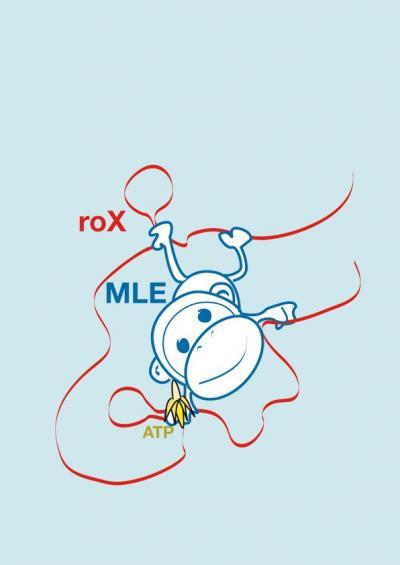X chromosomes are special, even for genetic material. They differ in number between men and women and to achieve equality between sexes, one out of two X chromosomes in women is silenced.
In Drosophila, the opposite happens: in male flies, the only available X chromosome is highly activated, to compensate for the absence of the second X-chromosome.
Researchers from the Max Planck Institute of Immunobiology and Epigenetics (MPI-IE) in Freiburg haveshown how the RNA molecules and proteins involved in the activation find and stick to each other. Similar to the way a monkey that grabs a liana with hands and feet, one of the proteins holds on to the RNA, then it molds the molecular liana with its hands and generates a dynamic RNA - protein meeting place.

The protein MLE grabs the RNA strand like a monkey grabs a liana. One site serves as a simple anchor (feet), while the other is able to mold the strand. This consumes energy (banana). The molded RNA allows other proteins to bind and thus to activate the X chromosome in male flies. Credit: MPI of Immunobiology and Epigenetics Ibrahim Ilik, Tugce Aktas
Years ago, they were assumed to be DNA sequences that are not translated into proteins but today it is widely known that much of the DNA is transcribed into RNA that, in turn, can act as gene regulator and structural element. Also in the regulation of sex chromosomes, RNA plays a central role. In both female humans and male flies one X chromosome is covered by a protein-RNA complex. In humans, this leads to chromosome silencing, while in flies it results in a double activation of the chromosome. Misregulation is lethal. Although known for many years, the interaction between the central proteins and the distinct role of the RNA strand was unclear.
Asifa Akhtar of the MPI-IE and her team now unravelled the function of the RNA and the interaction of the proteins. The protein MLE that is known to be a central player in X chromosome activation binds to the RNA in a very special manner. Like a monkey that grabs a liana with hands and feet, the protein grabs the RNA in two different ways. While one site is a simple anchor (the feet), the other (the hands) changes the form of the RNA.
"The protein MLE moulds the RNA strand. This allows MLE to bind the RNA in a dynamic manner," says Asifa Akhtar, head of the study. Like one monkey helping the other to catch the liana MLE could thus help other proteins to grab the RNA strand. Thus, the whole X chromosome can be covered by the RNA-protein complex."
During his PhD work, first author Ibrahim Ilik investigated why MLE was found at the same places on the X chromosome but did not directly interact with other proteins. "The biochemical and the biological results seemed to point in different directions in the beginning," says Ilik. "But when we realised that the proteins bind highly specifically to certain regions of the very long RNA, this was a very exciting moment."
The researchers also found that individual mutations in the RNA hardly harm the protein-RNA binding. Only multiple mutations lead to a non-functional RNA and thus to lethality of male flies. "The system is very robust for evolutionary influences. This shows how important it is for the survival of the animals. In this, RNA could provide the necessary plasticity," says Akhtar.
The scientists now want to explore the evolutionary conservation of the RNA-protein system and its equivalent in mammals.
Citation: Ibrahim Avsar Ilik, Jeffrey J. Quinn, Plamen Georgiev, Filipe Tavares- Cadete, Daniel Maticzka, Sarah Toscano, Yue Wan, Robert C. Spitale, Nicholas Luscombe, Rolf Backofen, Howard Y. Chang and Asifa Akhtar , 'Tandem stem-loops in roX RNAs act together to mediate X- chromosome dosage compensation in Drosophila', Mol Cell, 51/2, July 25, 2013 doi: http://dx.doi.org/10.1016/j.molcel.2013.07.001




Comments